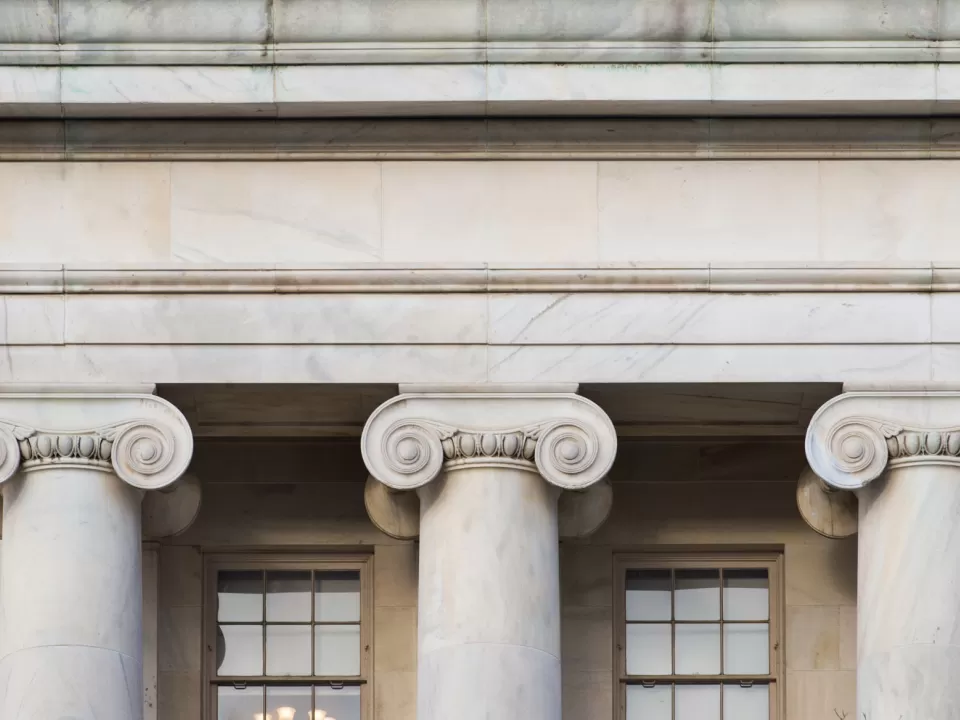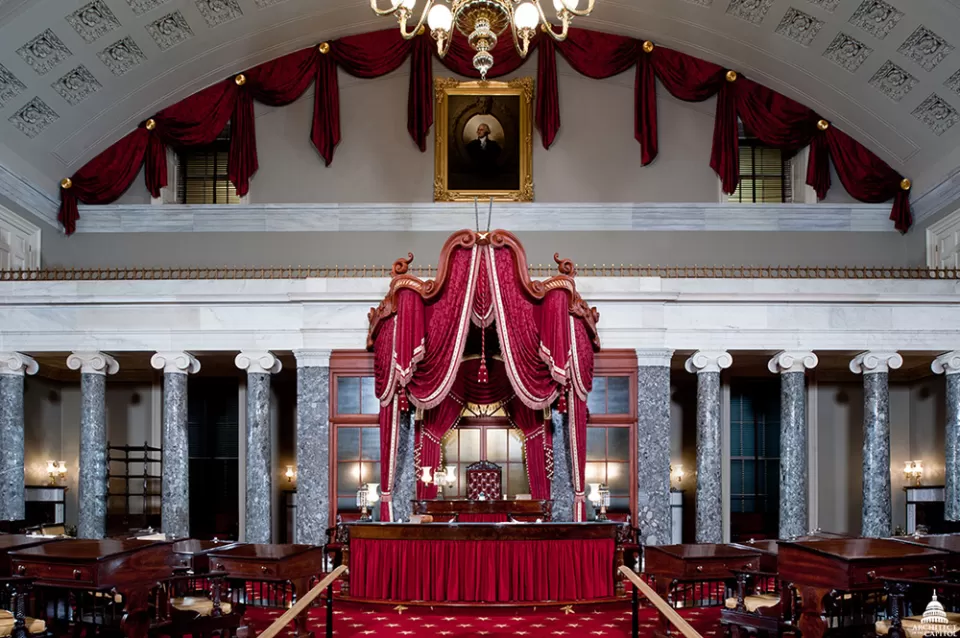When did the Congress first meet in the Capitol Building?
November 17, 1800.

Highlight
Ionic Columns
The Ionic column is typically identified by its capital, which includes large paired spiral scrolls, or volutes.
Senate Wing
Located north of the Capitol Rotunda is the richly decorated Old Senate Chamber. Designed by Benjamin Henry Latrobe, this room was home to the U.S. Senate from 1819 until 1859 and later to the U.S. Supreme Court from 1860-1935. Today the restored Chamber is used primarily as a museum, recreating the scene of many significant moments in the evolution of the United States Senate and the legislative history of the nation.
Located in the eastern half of the old north wing in the U.S. Capitol, the Old Senate Chamber is a semicircular room 75 feet in diameter covered by a half dome. It was designed by Benjamin Henry Latrobe and constructed by him and his successor, Charles Bulfinch, in 1815-1819. Latrobe modeled the chamber after similar rooms he had seen in Paris, which he considered ideally suited for hearing, speaking and seeing. He employed marble columns based on Grecian examples to support the visitor's gallery along the eastern wall. In 1828 Charles Bulfinch added a second gallery supported by slender cast-iron columns along the curving western wall.
The Senate met in this room from 1819 until its new chamber was ready in 1859. The next year the Supreme Court took over and remained here until moving across the street in 1935. For the next 40 years the room was used as a meeting or entertainment room. It was restored in 1976 to commemorate the history of the Senate.
Modeled after the amphitheaters of antiquity, the two-story Chamber is semicircular in shape and measures 75 feet long and 50 feet wide. The ceiling is a half dome. Two visitors' galleries overlook the Chamber. The gallery on the east wall is supported by eight Ionic columns of variegated marble quarried along the Potomac River; they were inspired by the columns of the Erechtheion in Athens. A second and much larger "Ladies' Gallery" follows the curved western wall. It is carried on 12 steel columns encased in cast-iron forms with Corinthian capitals, which were designed to simulate the cast-iron originals. A wrought-iron balcony railing follows the contour of the gallery and is backed by crimson fabric that accentuates the decorative metalwork.

Directly above the east gallery hangs an 1823 "porthole" portrait of George Washington by Rembrandt Peale, who had painted Washington from life. This portrait was purchased in 1832, the centennial of Washington's birth, for display in the Chamber.
A curved table with richly turned and carved legs and a crimson modesty screen sits on a raised platform in the center of the room. This is the desk of the Vice President of the United States, who serves as President of the Senate. The desk is crowned as a place of importance by an elaborate canopy with a mahogany valence from which crimson fabric is hung. A carved gilt eagle and shield stand above the valence. Directly in front of the Vice President's desk, but one tier down, is a larger desk of similar design; this was occupied by the Secretary of the Senate and the Chief Clerk.
A glass screen separates the Vice President's dais from a small lobby where Senators could go to relax yet still listen to floor proceedings. Two fireplace mantels are located on the east wall behind the screen; both are original to the Chamber. Two additional mantels on the north and south ends of the lobby are reproductions; the originals were replaced with stoves when the Chamber was converted for the use of the Supreme Court.
Radiating from the Vice President's dais on four semicircular, graduated platforms are 64 Senator's desks and chairs. Reproduced from a circa 1819 design by the New York cabinetmaker Thomas Constantine, these desks and chairs are mahogany. (The original furniture was moved into the present Senate Chamber when the Senate first occupied it in 1859; much of it is still in use there.)
Immediately behind the last row of desks is a low paneled wall that separates the Senators' space from a third visitors' area. Furnished with red-upholstered sofas, this area was reserved for privileged visitors who gained admittance to the Chamber through the special invitation of a Senator. Niches, one on either side of the main doorway, house reproductions of stoves that were capable of burning wood or coal.
The crimson and gold color scheme seen in the canopy and modesty screens is repeated throughout the Chamber. Crimson drapery swags secured with gilt stars adorn the visitors' galleries. Window treatments use the same crimson material. The Chamber floor is covered with a carpet woven from long-staple, 100% virgin wool. It features a gold star pattern on a red background.
The domed, white-painted ceiling of the Chamber is elaborately coffered and enriched by decorative moldings. A central, semicircular skylight is bordered by five smaller circular skylights; they originally provided the Chamber with natural light but are now artificially lit. Additional light was provided by a large brass chandelier made by Cornelius and Company, a prestigious Philadelphia firm, similar to the one now hanging above the Vice President's desk.
The Old Senate Chamber as it exists today is the third Chamber created for the use of the Senate in the U.S. Capitol. The original Chamber, designed by Dr. William Thornton, was located on the ground floor of the north wing. However, the wing deteriorated so rapidly that plaster walls and ceilings were crumbling and wooden floors were rotting after only 6 years of use.
Consequently, Capitol architect Benjamin Henry Latrobe decided to gut and completely rebuild the interior of the wing. Using vaulted construction, as he had in building the south wing, Latrobe raised the Chamber to the second or principal floor to make it level with the Old Hall of the House (now called National Statuary Hall). A ground-floor Chamber just below the Senate was created for the Supreme Court. Construction began in 1808 and the Senate moved into the space 2 years later. However, occupancy of the new quarters was short lived: the Senate Chamber was destroyed by fire, along with most of the rest of the building, during the War of 1812. Latrobe returned to Washington to oversee the Capitol rebuilding project and, at the request of the Senate, enlarged the Chamber to its present dimensions. Architect Charles Bulfinch assumed control of the reconstruction effort following Latrobe's resignation, and he completed the Chamber by December 1819.
The Senate met in this Chamber continuously for the next 40 years. During this period, the Senate was embroiled in the great national debates of the 19th century, with slavery the dominant issue. The Missouri Compromise of 1820 was hammered out here. The Hayne-Webster debates of 1830, concerning the right of states to nullify federal laws, were staged here, as were the Webster-Clay-Calhoun debates of 1850. Washington's elite gathered to watch the impassioned oratory and the great compromises that took place in this Chamber.
The United States grew rapidly during the 19th century, and the growing membership in Congress prompted an enlargement of the building during the 1850s. In 1859 the Senate relocated to its more spacious present Chamber in the new Senate wing. The vacated meeting place was quickly claimed by the Supreme Court, which moved to the second-floor Chamber in 1860. The Court continued to meet in the room for 75 years. The Court's tenure in the Capitol had always been considered temporary, and in 1935 the long-awaited Supreme Court building finally opened. Following the Court's departure, the space was used as a meeting room until its restoration in 1976.
The Old Senate Chamber was returned to its mid-19th-century appearance in anticipation of America's bicentennial. Few original furnishings were available for display in the restored Chamber, and thus many of the objects had to be reproduced based on historical evidence and informed conjecture. An 1842 engraving of the Chamber by Thomas Doney, with its careful attention to details of the room's architecture and furnishings, was an important source of information for the restoration. Structural modifications made to the Chamber included the installation of a new raised floor over existing masonry. Existing ceiling beams were covered with fire-resistant material, and coffer ornaments were recast in plaster. The Ladies' Gallery, which had been removed in the 19th century, was entirely reconstructed. On the north and south walls, marble faces and mantels were faithfully copied from the east wall mantels, which are original to the room. The carpet pattern was derived from contemporary illustrations of the Chamber, as was the design for the oil- burning chandelier, which was electrified for practical reasons but designed to simulate the glow of oil illumination. The Webster desk was selected as the prototype for the reproductions of the Senators' desks because it survives in its original condition. Similarly, the existing Vice President's desk was used as a model for the creation of a new clerk's desk. The gilt eagle and shield are original to the Chamber, while the reproduction of the canopy was based on a variety of illustrations.
Today, the restored Chamber is used primarily as a museum, recreating the scene of many significant moments in the evolution of the United States Senate and the legislative history of the nation.
November 17, 1800.

Highlight
The Ionic column is typically identified by its capital, which includes large paired spiral scrolls, or volutes.
Senate Wing